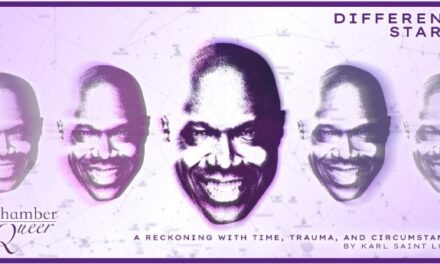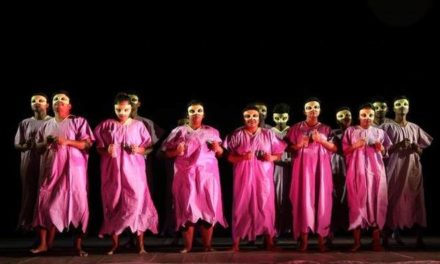Indian Women’s Performance Art: Un-coding Gender and Sexuality
Performance Art’s fostering a mode of presentation free of the encumbrances of via-media offers artists the advantage of escaping the limitations of behavioural codes, and exploring the politics of identity. This mode is more direct as well as barer as it is shorn of ‘props’ such as stagecraft and setting. For women practitioners, this implies the possibility of an expression unfiltered through a constricting discourse like patriarchy. It offers them the freedom of an experiential rather than a precedented art. This paper shall look at how Indian women’s Performance Art challenges codes of gender and sexuality inherent in the Indian social setup. After outlining the elements of the genre, the contexts and practices of Indian women’s Performance Art shall be discussed. Within this framework, one work each by two Indian women Performance Artists—Sonia Khurana’s Bird (1999) and Tejal Shah’s Stinging Kiss (2000)—shall be analysed.
https://www.youtube.com/watch?v=SHV5_fqKTbU
Conceptualizing Performance Art
There is an inherent stumble block in arriving at a definitional understanding of Performance Art due to the intermingling of various elements in this form. However, one shall attempt to arrive at a broad conceptual understanding. The term ‘Performance Art’ emerged in the 1960s. It refers to an unconventional form of art, having a political bent, presented live to an audience. It is interdisciplinary, borrowing from theatre, dance, visual arts, poetry, etc. It is more a process than a finished product. In it, artists engage in a singular or multiple actions for a specific duration, in a specific site. The site could be any space— art museums, cafes, streets, etc. Likewise, the actions could include anything— lying down, painting one’s body, sleeping, and so on.
In Performance Art: From Futurism to the Present (2001), RoseLee Goldberg identifies Futurism, Constructivism, Dada, Surrealism and the Bauhaus school as influences on this form. These movements have accorded it an avant-garde nature. The live nature of the art imparts it a uniqueness and irreproducibility, thus making it ephemeral and intangible. Such elements are seen as challenging the commodification and institutionalization of art. Performance Art is dependent upon corporeality and embodied-ness. It is the interaction of the artist’s body with an audience, at a particular time that lends the art credibility and reality; imbuing it with an ongoing creativity wherein the audience offers its own meaning and shape to the art. It does not involve ‘acting’ because it does not adhere to a plot. It is merely the ‘doing’ of an actual action, which has some concentrated, evocative and political import. This is where the art happens. Amanda Coogan puts it thus in ‘What is Performance Art?’: “The performance frame is contingent and temporary, holding the performer in a liminal, provisional and suspended place. This frame of performance time is a particular construct the artist or performer steps into” (11).
Despite the stress on the live presentation of Performance Art, certain hindrances involved in a wider audience mobilization and the need and desire to bring the art to visibility have made its documented presentation and reception acceptable. In Body Art/The Performing Subject (1998), Amelia Jones claims that a documentation of Performance Art should be considered as valid because an audience can equally well arrive at a critical understanding of such documentation since it also makes the work distant and neutral. Hence, this paper shall look at Khurana’s and Shah’s works through documentation, focusing on the politics, rather than the liveness of the interaction.
Women’s Performance Art in India: Tracing a Location and a Genealogy
Women’s Performance Art in the West acquires theoretical basis and motivations (consciously or unconsciously) from rewritings of Lacanian conceptualization of subjectivity and desire as inherently male by feminists like Julia Kristeva (who pits the ‘semiotic’ mode of language as challenging the rigidity of patriarchal discourse) and Helene Cixous (who exhorts women to “write their bodies” through sexuality). In India, patriarchal discourse is somewhat differently generated. Here, a religious discourse operates around the construction of women’s identities. A woman is associated with spirituality and is reified as sacred. On the other end of the spectrum, a sexualized image of the woman is formulated and is condemned as demon-like. Ironically, the two images can never be accepted as co-existent. A woman in whom a conscious subjectivity, sexuality and desire cohere does not appear as acceptable. However, images of masculinity are circulated only in terms of the possession of power.
In Indigenous Roots of Feminism (2011) Jasbir Jain discusses how Indian patriarchal structures contain the identities of women. She points out that origin myths like those in the Upanishads prescribe a dualistic philosophy of soul and body which is taken to be representative of gender roles and relegates an inferior position to women (26). Indian religion offers unmediated relationships such as the four ashramas (states) of life to men, whereas women are merely prescribed rituals like fasting which curbs desire in women. The female body is contained through puberty, pregnancy, rape, feticide and adornments, reducing it to a procreator and moralizer. Another important structure is that of language which is based on masculine terms. Very often, women are denied education, confining them to a private discourse. Hence, women deal with the problem of “writing the self” through “body language, response, action and … the act of writing … Oral histories, folk songs and sharing sessions are other ways of articulation” (Jain 2011: 218-19). The structures of sexuality and psychology are also based on male norms and ascribe to women either passivity or an urge for protection. Female sexual desire oscillates between guilt and immorality. Hence feminist expression in India requires an acknowledgement of the wholeness of women’s identities including sexuality and stressing on the body as a liberating force.
As such Indian women performance artists work against phallocentric representations that create out of ‘woman’ a singular, undifferentiated sign incapable of an agency. The agenda is to infuse women with the subjectivity denied to them by patriarchy. It is of paramount importance, as Jeanie Forte points out in ‘Women’s Performance Art: Feminism and Postmodernism,’ to utilize postmodernist deconstructive methodologies to de-structure the constructed subject-position resulting from cultural practices. This has led to the use of the body as an embodied presence, which by being the carrier of the accoutrements of signifiers and ideologies, could become a subversion of these very contexts. As pointed out by Annette Arlander in ‘Is Performance Art Self-Portraiture? – Me or Other People as Medium’, it is not just a “universal, sculptural and corporeal body” that women performance artists use, but a “gendered, ethnically and racially defined body” that is reinterpreted for identity politics (13). This is because the body cannot be devoid of signification. By offering the body without the staging of socio-cultural associations women performance artists launch a critique of those associations by suggesting their dispensability and irrelevance. Judith Butler raises similar questions in Gender Trouble (1990): “Bodies cannot be said to have a signifiable existence prior to the mark of their gender … How do we reconceive the body no longer as a passive medium or instrument awaiting the enlivening capacity of a distinctly immaterial will?” (13).
Accordingly, the practices of Indian women performance artists have been exploratory. Ratnabali Kant’s Facing Nightmare Alone (1991) included diverse elements like dance, sculpture and theatre. It dwelt upon Draupadi’s chirharan (disrobing) in the Mahabharata. The stress upon Draupadi’s isolation and sexual slur are noteworthy. Pushpamala N has worked in photographic series. Sunehre Sapne (2001) included the fantasies of a middle-class housewife in hand-painted photographs. This reflects the experience of inhabiting various identities and deconstructs stereotypes of women.
Rummana Hussain’s Living on the Margins (1995) involved applying an indigo-coloured washing detergent on her feet and walking in the garden of NCPA, Nariman Point. This questioned the position of women as victims in times of political turmoil. In Is it What You Think? (1998) she questions the construction of Muslim women’s identities. The newspaper images of Muslim women played on a slideshow while Hussain raised questions about Islam, simultaneously removing her hijab. One of Jasmeen Patheja’s works involved requesting women to offer clothes in which they were sexually harassed. These clothes were then displayed, questioning the idea that rape resulted from provocative dresses worn by women. Surekha’s work examines the issue of women’s unnatural deaths by burning and drowning. In Three Fragmented Actions of Silence she uses technological elements like superimposed images to comment on gender issues and violence. Mrs. Manmeet’s Performance Art has ranged from her and her husband summoning the audience to write on their nude bodies to kissing in public places. Such art calls for a fresh examination of sexuality and women’s nude bodies in a public place.

Rummana Hussain’s Living on the Margins. Performance at the National Centre for Performing Arts, Mumbai, 1995. Press photo
In Indian women’s Performance Art therefore, apart from other issues, a preoccupation with women’s marginalization has been central. The collusion of cultural, religious and political discourses in subjugating women is probed. Such art-works reform the spatial segregation of women by pursuing personal issues of women’s lives in public spaces. By bringing their art into the everyday they infuse it with greater audience-performer interactivity, also implicating the audience in the issues being addressed. Shah’s and Khurana’s works take forward such trends, as shall be discussed in the next section.
Tejal Shah’s Stinging Kiss and Sonia Khurana’s Bird: Repositioning the Body
In Stinging Kiss Shah recreates a typical scenario from Bollywood films— the heroine’s abduction by the villain and the hero’s chase to save her. Bollywood’s representation of romance, fantasies of rape, the portrayal of sex in pornography are the diverse images that get superimposed upon each other in this video work. The artist’s statement on Shah’s website describes the work as a displacement of “the viewer’s subject position.” This is a useful entry-point into an understanding of the politics of the work. Since Shah plays the dacoit and her male collaborator plays the trapped woman, traditional sexual roles of active masculinity and passive femininity are reversed. In addition, it is not merely the displacement of the viewer’s subject position, but also that of the male as subject. The subjectivity of the woman comes in as she toys with the male-playing-the-abducted-female. The subject-object relationship is toppled and the man gets a taste of the commodified fetish. The gagging of the mouth and chaining of the hands are crucial signifiers of silencing and disempowering the male. His caging and crawling further assign him an abject status.
Another important aspect is the acknowledgement of female sexual desire. The woman appears not merely as a subject, but as a desiring subject, creating a space for the confusion of gender and sexual binaries, where being a man or a woman is no longer relevant. Forte’s stress on deconstructive methods for re-visioning subjectivity can be seen at work here. The choice of Bollywood and pornography scenarios is pertinent because this both resists patriarchal discourses associated therewith and also takes up readymade ‘roles’ for re-visioning. Further, it is the rape fantasy of the male that is being considered. In the same stroke, Shah is able to reconsider not just the origin of sexual desire but also that of sexual exploitation, highlighting the perversion of the pleasure derived by the male during rape. The ‘gaze’ emerges from the female and the man is reduced to a spectacle. From an assumed position, it is the body of the woman which becomes the site from where the discourse of desire and subjectivity emanates. The fact that this is an assumed position and also that the space in the ‘act’ is an imaginary one emerging from a cinematic scenario, raises an important question. Can ‘real’ spaces of our society not accommodate the desire and subject position of women? If, as Jain observes, domestic spaces add guilt to women’s desire and public spaces make it immoral, then will women have to continuously carve out such wish-fulfillment spaces (like Kristeva’s ‘semiotic’) for channelizing their desire? The answers cannot be simplistic.
This work does not have any dialogue or speech. The focus is on actions. This is made possible by the form which does not prescribe set standards of acting. Due to the stress on gestures, an analysis of certain modes of behaviour with respect to gender position is undertaken. To use Butlerian terminology, the woman appears in ‘drag’ but the tone of derision towards social codes is so prominent that it entirely takes away the seriousness from the discourse of gender. The empowering ‘queer’ status of Shah further complicates the gender divide, because a ‘queer’ subject reversing heterosexual norms by assuming masochism over a male playing a woman, is complex at multiple levels.
The incorporation of multiple generic patterns is another aspect brought in by the peculiarity of the form. A narrative from cinema revised through a personal video recording, presented at art museums, galleries and film festivals as a work of Performance Art defies generic expectations associated with a single form. It grants a space of experimentation which further aids in relocating discourses. Thus, in Stinging Kiss Shah transforms the woman’s body from the object to the objectifier and unsettles expectations of reading this body in a normative way. The conventional Indian associations of guilt and coyness are dissociated from this body as it enters into the role of a demanding voyeur, liberated and empowered.
In Bird, Khurana too uses her body as a site of transgression but in a slightly different manner. Erin Striff in ‘Bodies of Evidence: Feminist Performance Art’ and Jill Dolan in ‘The Dynamics of Desire: Sexuality and Gender in Pornography and Performance’ have warned against the use of nudity in women’s Performance Art as this could invoke the signification of a sexualized entity associated with it. However, Khurana’s ‘performance’ of her nude body is done in a manner that resists fetishization. It dwells instead on the woman artist’s comfort with her body, establishing a sense of identity through it and exploring it beyond the role of a sexual signifier.
Bird shows Khurana’s nude and overweight body in attempts at ‘flying’ in various positions of a bird, each of these attempts being frustrated. Her overweight body defies fetishistic male gazing for visual pleasure because it is nowhere near the ideal anatomy of females which is considered as sexually stimulating. So there is inevitably a distance involved in the audience’s gaze when it meets a figure that does not correspond to expected sensuality. The work comprises of random movements done in a haphazard, unplanned fashion. It lacks grace and poise and has a mechanical, start-stop quality to it. The moves are brisk and almost clumsy at some places. There are awkward moments of falls and imbalance. The whole scenario thus acquires an extremely humorous quality. Moreover the editing has been done in a manner that accentuates the discontinuities and falls of the flight. To add to this, the recording has been done with a hand-held, slightly off-the-focus, and shaky camera, which multiplies the odd nature of the moves. All of this serves to further discourage attempts at deriving fetishistic pleasure from the display of the woman’s nude body, because nowhere is its conventional beauty harped upon.
The ineffective attempts at flying can also be read as the body’s entrapment within patriarchal injunctions, and its continued efforts to somehow break free from them. The physical body being bound by the rules of gravity and the flesh becomes a metaphorical representation of the woman’s identity being pinned down by ideals of femininity. By placing the body within various positions and moves, and focusing specifically on these gestures and eliminating speech, it is an awareness and acceptance of the body and the self that is being dwelt upon. External signs can be dispensed with; it is the internal knowledge and experiences of the body (impacting the psyche), that constitute the woman’s subjectivity. As Khurana states in an interview with Nonika Singh, “Isn’t self the starting point of a better understanding of the world and truth? … Actually through my body I am trying to internalise my experiences and exploring the world almost like a ritual.” In some ways then, Bird can be seen as a self-portraiture, in coming to terms with both the disempowering nature of the representation of womanhood as well as the necessity for an actualisation of unbound experience in selfhood. The comic manner of portraying these twin impulses also suggests a mockery of women’s image-construction to which the self-image of a body looking for ease with itself can be pitted as an alternative.
Stinging Kiss and Bird were not performed in front of a live audience but were video-recorded and presented at art galleries, museums and film festivals later. This gives these works a displacement from a time-bound fixation and the dislocation from a particular site also signifies the uprooting of the discourse of gender, sex and desire from its (im)material basis. Rather, these works are the artists’ own probing of certain aspects of selfhood and gender at a personal level, by politicizing the personal. In other words, the very idea of an ‘audience’ is at stake here because the woman’s bodily investigation of gender norms and feminine anatomical signifiers precludes the presence of those watching her. ‘Who’ is seeing is not as important as ‘how’ she is being seen.
These works are not based on scripts or externally authored texts. The author and performer are one here and the text is the woman’s body which refuses to be read through male-prescribed parameters. Such a method represents women as ‘speaking subjects’ since, as Forte points out, “the revolutionary text of [women’s] actual bodies” (226) is incongruous with its patriarchal representations. These works are similar to those by other women performance artists in India in their address to women’s inscription in discourse and are also a development of other techniques through a unique use of the woman’s body which is dislocated from conventional sites and contexts. In ‘The Performative Space: Tracing the Roots of Performance-based Work in India’ Swapnaa Tamhane establishes the intensely politicised nature of Indian Performance Art and audience reception, as a few crucial determinants of the Indianness of this form. Considering the fact that Bird met with an unreceptive response initially in India and that Shah has often found herself engaging in self-censorship vis-a-vis the Indian milieu, the strength of these works probably lies in the fact that in comparison to their Western counterparts like Carolee Schneeman and Marina Abramovic, these artists have ‘performed’ themselves against a doubly hostile ‘audience.’ As a result, their commitment towards gender politics has reconceptualized the whole concept of audience relations and facilitated the demonstration of (and also enhanced) these artists’ understanding and awareness of the self as subject and object.
Bibliography
Arlander, Annette. ‘Is Performance Art Self-Portraiture? – Me or Other People as Medium’ in Converging Perspectives – Writings on Performance Art, Annette Arlander (ed.), Episodi 3, Theatre Academy 2011, pp. 8-26.
Butler, Judith. Gender Trouble: Feminism and the Subversion of Identity, New York: Routledge, 1990.
Dolan, Jill. ‘The Dynamics of Desire: Sexuality and Gender in Pornography and Romance’ in Theatre Journal, 39.2 (1987): 157-74.
Forte, Jeanie. ‘Women’s Performance Art: Feminism and Postmodernism’ in Theatre Journal, Vol. 40. 2, (May 1988):217-35.
Goldberg, RoseLee. Performance Art: From Futurism to the Present. London: Thames and Hudson, 2001.
Jain, Jasbir. Indigenous Roots of Feminism: Culture, Subjectivity and Agency. New Delhi: Sage Publications, 2011.
Jones, Amelia. Body Art/Performing the Subject. Minneapolis: University of Minnesota Press, 1998.
Mulvey, Laura. 1975, ‘Visual Pleasure and Narrative Cinema’ in Screen, 16, 3, (Autumn 1975): 6-18.
Striff, Erin. ‘Bodies of Evidence: Feminist Performance Art’ in Critical Survey 9.1 (1997): 1-19.
Web Sources
Coogan, Amanda. ‘What is Performance Art?’ Imma, Date of access- 10 June 2014.
Girin, Diane Sophie. ‘Sonia Khurana’. Trans. Yin Ker. Newmedia-art. Date of access- 15 June 2014.
Khurana, Sonia. Interview with Nonika Singh. Tribuneindia, 2 March 2014. Date of access- 27 June 2014.
Shah, Tejal. Interview with Natasha Bissonauth. Aapmag, 2009. Date of access- 22 June 2014.
Tamhane, Swapnaa. ‘The Performative Space: Tracing the Roots of Performance-based Work in India’. Swapnaatamhane, Date of access- 16 June 2014.
This article was originally posted on MuseIndia.com. Reposted with permission. To read an original article, click here.
This post was written by the author in their personal capacity.The opinions expressed in this article are the author’s own and do not reflect the view of The Theatre Times, their staff or collaborators.
This post was written by Minakshi Kaushik.
The views expressed here belong to the author and do not necessarily reflect our views and opinions.




















